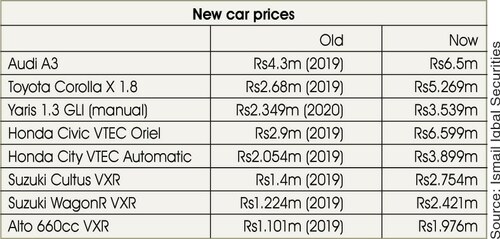Karachi: Amjad Lodhi, who owns a car rental company, bought a Toyota Corolla in 2019 for around Rs2.5 million. Having paid off the amount in three-year instalments, he recently sold it for Rs3m, a cool Rs500,000 more than the original price. But he doesn’t seem satisfied. Reason: the sticker price has now crossed Rs5m.
This is partly why people want to sell their old vehicles at higher prices. They want the difference to be as small as possible when they buy a new one.
“If a new car adds Rs500,000 to its price, consumers demand an extra Rs200,000-250,000 for their old vehicles,” Mr Lodhi said.
Abdul Nasir, who drives for a ride-hailing service, faces a similar situation. He has an offer of Rs630,000 for his Suzuki Cultus 2006 model, a car he bought for Rs550,000 less than a year ago. “It’s a great offer, but I must have the extra money in my pocket to get an advanced model,” he said.
So, a record rise in vehicle prices is a kind of double-edged sword for most people who want to upgrade.

Still, car prices have skidded out of control so fast that some people have even started treating them like real estate, though property stakeholders say sectors like auto and currency are volatile and may not be the best option in the long term.
However, even from a short-term perspective, returns on vehicles in the past year are higher than on other major assets. Fahad Rauf, head of research at Ismail Iqbal Securities (IIS), said the return on real estate and gold was 19 per cent and 35pc. However, vehicles like Kia Sportage, Suzuki Alto 660cc, Toyota Corolla and Suzuki Cultus turned in returns of 38pc, 47pc, 48pc and 64pc, respectively, over the same period.
Samiullah Tariq, head of research at Pak Kuwait Investment Company, said automobiles hold the top spot when it comes to returns, which have remained 20pc annually over the last two to three years.
All Pakistan Motor Dealers Association (APMDA) Chairman H.M. Shahzad said prices of used cars had risen by 25-30pc in the last three years depending on the model and condition. In contrast, prices of locally assembled vehicles have doubled since 2019, he said.
This gap widens when you add “own money” — a black-market premium collected predominantly by manufacturers and dealers thanks to a low supply of vehicles and advanced booking.
“Demand for used cars will remain upbeat if prices of locally made cars continue to grow,” Mr Shahzad said.
Mr Lodhi, the car rental business owner, believes that today prices are mostly driven by the exchange rate, mainly because local vehicles heavily rely on imported components.
In some cases, car prices have gone up even in dollar terms — perhaps because the rupee has depreciated faster than the cars themselves.
For instance, the price of Corolla Altis 1.6 (manual transmission) was around Rs2m in February 2014, or around $20,000 at the time. It was then recorded at Rs2.15m ($20,660) in December 2017, Rs2.45m ($21,600) in June 2018, Rs3.15m ($19,700) in July 2019, Rs3.16m ($19,000) in April 2020, Rs3.109m ($20,000) in July 2021, and Rs4.89m ($23,900) this July.
Real estate
As for the property market, stakeholders offer mixed views depending on the area and the type of property.
Association of Builders and Developers (Abad) Chairman Altaf Tai said an average apartment now costs 40pc more than it did three years ago, whereas house prices have seen 25-30pc growth depending on the area and project.
Abdul Wahab Parekh, a property consultant based in Karachi’s Clifton area, said prices plunged 25-40pc from 2018 to 2020, but then recovered from 2021 to 2022 by 15-20pc.
The property trade is down 60 per cent, he said, and only “genuine deals” are being struck between buyers and sellers these days.
Mr Parekh said investors were unwilling to take risks because of the uncertain rupee-dollar parity, an unstable political environment, multiple economic crises, government departments’ stern checking on property deals and high deputy commissioner and valuation rates.
In Karachi, an old 1,000-square-yard, two-storey bungalow costs Rs180-190m compared to Rs150-160m in 2019, whereas a similar-sized maintained bungalow costs Rs220m versus Rs180m. A new 1,000 sq yd bungalow with a basement is sold for around Rs280-290m compared to Rs230m in 2019.
Besides, an open plot in DHA Phase VIII carries a price tag of Rs40m compared to Rs37.5m in 2019. However, the price soared to Rs47.5m in 2021.
As for apartments, Citi Associates CEO Muhammad Shafi Jakvani said prices in Clifton had almost doubled since 2019 due to a shortage. A three-bedroom old flat is available at Rs25m compared to Rs12.5m in 2019, while the price of a new flat is Rs60-65m compared to Rs30-35m.
He said this year had so far remained depressed for the property market in the posh area due to the absence of investors,“ he said, adding that investment was mostly going to housing projects in Scheme 33, Scheme 42 and industrial plots, where prices had jumped by four times in some cases, mainly due to escalating construction costs.
Still, Abad’s Mr Tai believes real estate reflected the “actual economic cycle,” while other sectors like auto and currency were speculative and volatile.
So, at a time when people have even started treating cars like gold, the property guys beg to differ and say one should not go for everything that glitters.
To them, the highest utility of a car is perhaps that it can take you to a real estate consultant.
Published in Dawn, October 18th, 2022














































